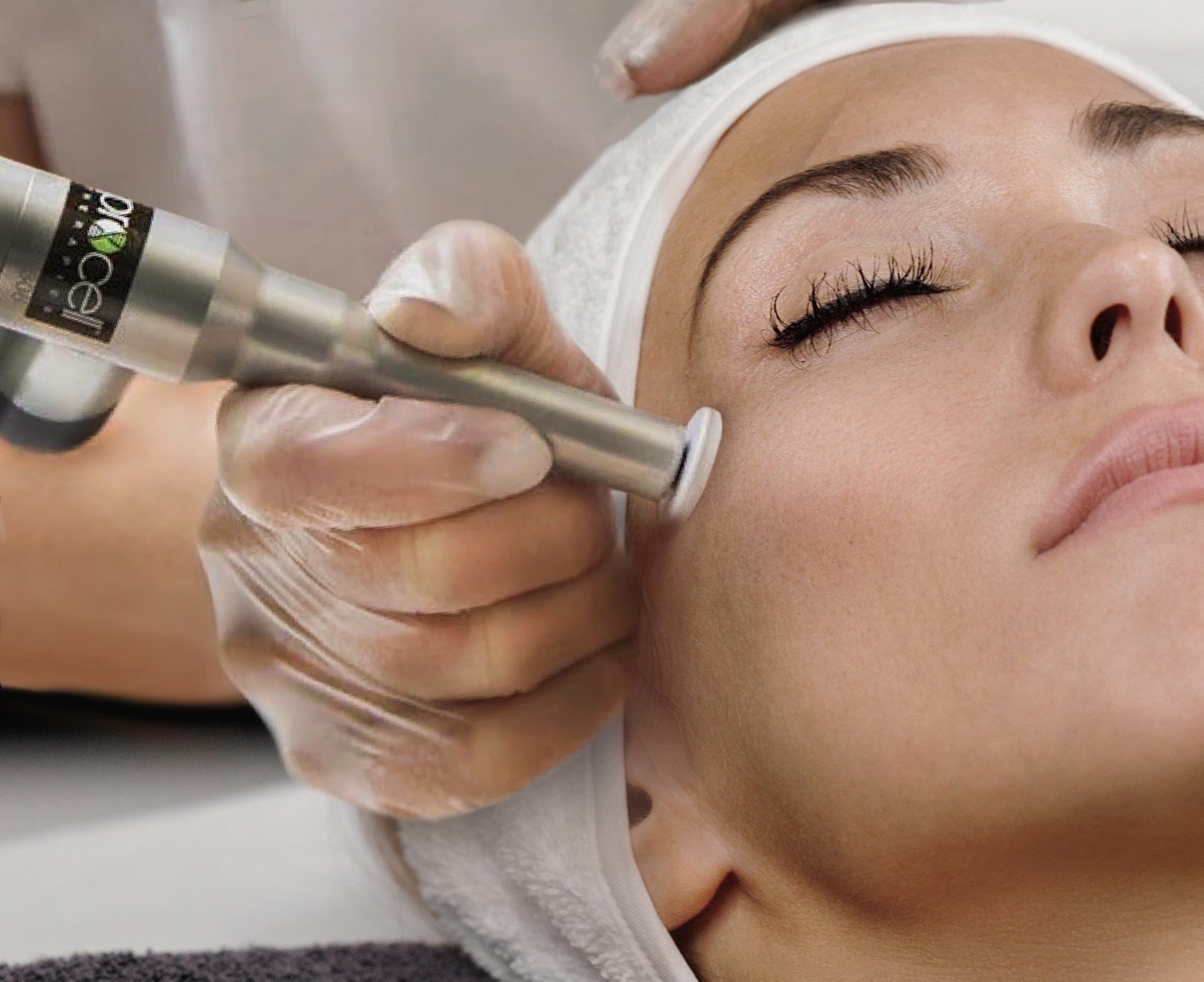
If you’re exploring advanced skincare treatments to rejuvenate your complexion, reduce acne scarring, or boost collagen, you’ve likely come across two similar-sounding options: microneedling and microchanneling. While they share some overlap, these procedures differ significantly in technique, recovery, and results.
At our clinic, patients often ask: “Is microneedling or microchanneling better for me?” The answer depends on your skin type, goals, and tolerance for downtime. In this guide, we’ll break down the science behind each treatment, how they work, what to expect, and which one may be the ideal choice for your skin.
What Is Microneedling?
Microneedling—also known as collagen induction therapy (CIT)—is a minimally invasive treatment that uses tiny needles to create controlled micro-injuries in the skin. These micro-punctures trigger your body’s natural wound-healing response, stimulating the production of collagen, elastin, and growth factors essential for youthful, healthy skin.
Microneedling Is Commonly Used For:
- Fine lines and wrinkles
- Enlarged pores
- Acne scars
- Stretch marks
- Uneven skin tone and texture
- Sun damage
Microneedling is typically performed with a handheld pen or roller. Needle depths can be adjusted based on the area treated and the severity of the skin issue.
What Is Microchanneling?
Microchanneling is often referred to as the next-generation version of microneedling. It uses a stamping technique with a precision-controlled, fixed-pattern device to create uniform micro-channels across the skin. These channels are ideal for delivering potent serums, like stem cells, peptides, or exosomes, deep into the dermis for maximum absorption and cellular regeneration.
Microchanneling Is Used To Address:
- Premature aging
- Scarring (acne, surgical, traumatic)
- Pigmentation issues
- Mild to moderate skin laxity
- Hair thinning and scalp rejuvenation
- Uneven skin texture
Because the device enters and exits the skin in a clean vertical motion, microchanneling is gentler on the skin and typically results in less inflammation and faster recovery.
Key Differences: Microneedling vs. Microchanneling
- Device Motion
- Microneedling: Glides or rolls across the skin
- Microchanneling: Uses precise vertical stamping
- Needle Insertion
- Microneedling: Enters at varying angles, more drag
- Microchanneling: Straight, controlled, vertical entry
- Precision & Consistency
- Microneedling: Depth depends on provider’s technique
- Microchanneling: Automated depth for consistent results
- Serum Delivery
- Microneedling: Optional, often uneven absorption
- Microchanneling: Integrated serum delivery during treatment
- Downtime
- Microneedling: 24–72 hours of redness and swelling
- Microchanneling: Mild redness, typically fades within 24 hours
- Pain Level
- Microneedling: Moderate discomfort; numbing is recommended
- Microchanneling: Minimal discomfort; numbing usually not needed
- Risk of Irritation
- Microneedling: Higher potential for skin trauma
- Microchanneling: Lower risk due to cleaner needle entry
- Ideal Candidates
- Microneedling: Best for deep acne scars or intensive skin renewal
- Microchanneling: Great for sensitive skin, early aging, and hydration
- Safety for All Skin Tones
- Microneedling: Safe when performed by experienced providers
- Microchanneling: Lower risk of pigmentation changes; safe for all skin tones
- Home Device Options
- Microneedling: Available but less effective and higher risk
- Microchanneling: Only offered by licensed professionals
How They Work: Side-by-Side Breakdown
Step-by-Step: Microneedling
- Numbing cream is applied to reduce discomfort
- A microneedling pen or roller glides across the face in multiple passes
- Tiny injuries trigger the release of collagen-building signals
- Skin may be red and sensitive for 1–3 days
- Gradual improvement in texture, scarring, and tone over weeks
Microneedling results are cumulative and usually require a series of 3–6 treatments spaced 4–6 weeks apart.
Step-by-Step: Microchanneling
- Skin is cleansed and sterilized
- A no-drag stamping device creates uniform microchannels
- A high-potency serum (e.g., stem cells or exosomes) is delivered during stamping
- Skin may be pink for a few hours; most people resume normal activity the same day
- Results appear faster, especially in hydration, glow, and skin bounce
Microchanneling also works best in a series of treatments, typically 4–6 sessions spaced 2–4 weeks apart.
Which One Is Better?
Here’s how we recommend choosing between the two:
Choose Microneedling if you:
- Have deep acne scars or stretch marks
- Want a more aggressive resurfacing approach
- Can tolerate 1–3 days of downtime
- Are not currently experiencing active breakouts or skin infections
Choose Microchanneling if you:
- Have sensitive or reactive skin
- Want faster recovery with less inflammation
- Are focused on glow, hydration, and plumping
- Want to enhance results with infused growth factors or peptides
Unique Benefits of Microchanneling
- Improved Product Penetration
Channels created during microchanneling allow serums to reach the deeper dermal layers, where active ingredients are most effective. - Minimal Trauma = Faster Healing
Because it uses a vertical stamping method, microchanneling causes less tearing, resulting in a lower risk of hyperpigmentation, scarring, or prolonged redness. - Safe for All Skin Types
Microchanneling is safe for all Fitzpatrick skin types, including darker skin tones, where the risk of post-inflammatory hyperpigmentation (PIH) is higher. - Hair Regrowth Applications
When paired with hair growth serums or exosomes, microchanneling can stimulate dormant follicles and reduce thinning on the scalp. - Less Pain, No Numbing Needed
The ultra-fine needles and rapid stamping motion make this a more comfortable experience for most patients.
Microneedling and Microchanneling Before and After Care
Pre-Treatment Tips:
- Avoid retinoids and exfoliants for 5–7 days prior
- Stay out of direct sun and tanning beds
- Come with clean skin—no makeup or lotions
- Let your provider know about any active breakouts, recent Botox/fillers, or medications
Post-Treatment Care:
- Avoid sunscreen and makeup for 24 hours
- Do not touch or pick the skin
- Use a gentle cleanser and apply only approved post-care products
- Avoid intense workouts, saunas, or sun exposure for at least 48 hours
- Sleep on a clean pillowcase and avoid hot showers the first night
Results typically begin to appear within 5–7 days and improve over the next 2–4 weeks.
Frequently Asked Questions
Is microchanneling better than microneedling?
Microchanneling offers greater consistency, less trauma, and better serum absorption, making it ideal for those seeking hydration, plumping, and minimal downtime. However, microneedling remains effective for deeper scarring and skin resurfacing.
Can I do these treatments at home?
Professional treatments are significantly more effective and safer. At-home rollers typically don’t penetrate deep enough to stimulate real collagen and can increase your risk of infection or uneven results.
Is it painful?
Most patients describe microchanneling as a “light tickle.” Microneedling can be more intense, but numbing cream helps significantly.
Can I combine these with other treatments?
Yes. Depending on your skin goals, microneedling or microchanneling can be paired with PRP (platelet-rich plasma), LED therapy, or chemical peels. Your provider can guide you on timing and combinations.
How long do results last?
Results can last several months or longer, depending on age, skin condition, and skincare habits. Regular maintenance treatments, 2–3 times per year, can help maintain long-term benefits.
Transform Your Skin
Whether you’re dealing with scars, dullness, or the early signs of aging, microneedling and microchanneling are two of the most effective non-surgical options available today. At Plastic Surgeons of Northern Arizona, we’ll help you decide which treatment is best for your skin goals and customize your experience for optimal results.
Book your consultation today and discover why patients trust us for safe, effective, and personalized skin rejuvenation treatments.
Author Profile: Brian Cripe, M.D., is an award-winning, board-eligible plastic and reconstructive surgeon and Plastic Surgeons of Northern Arizona partner. Dr. Cripe specializes in cosmetic surgery, limb salvage, peripheral nerve microsurgery, hand surgery, and oncologic reconstructive procedures. He has performed over 6,000 surgical cases during his nine-year tenure as a surgeon.




